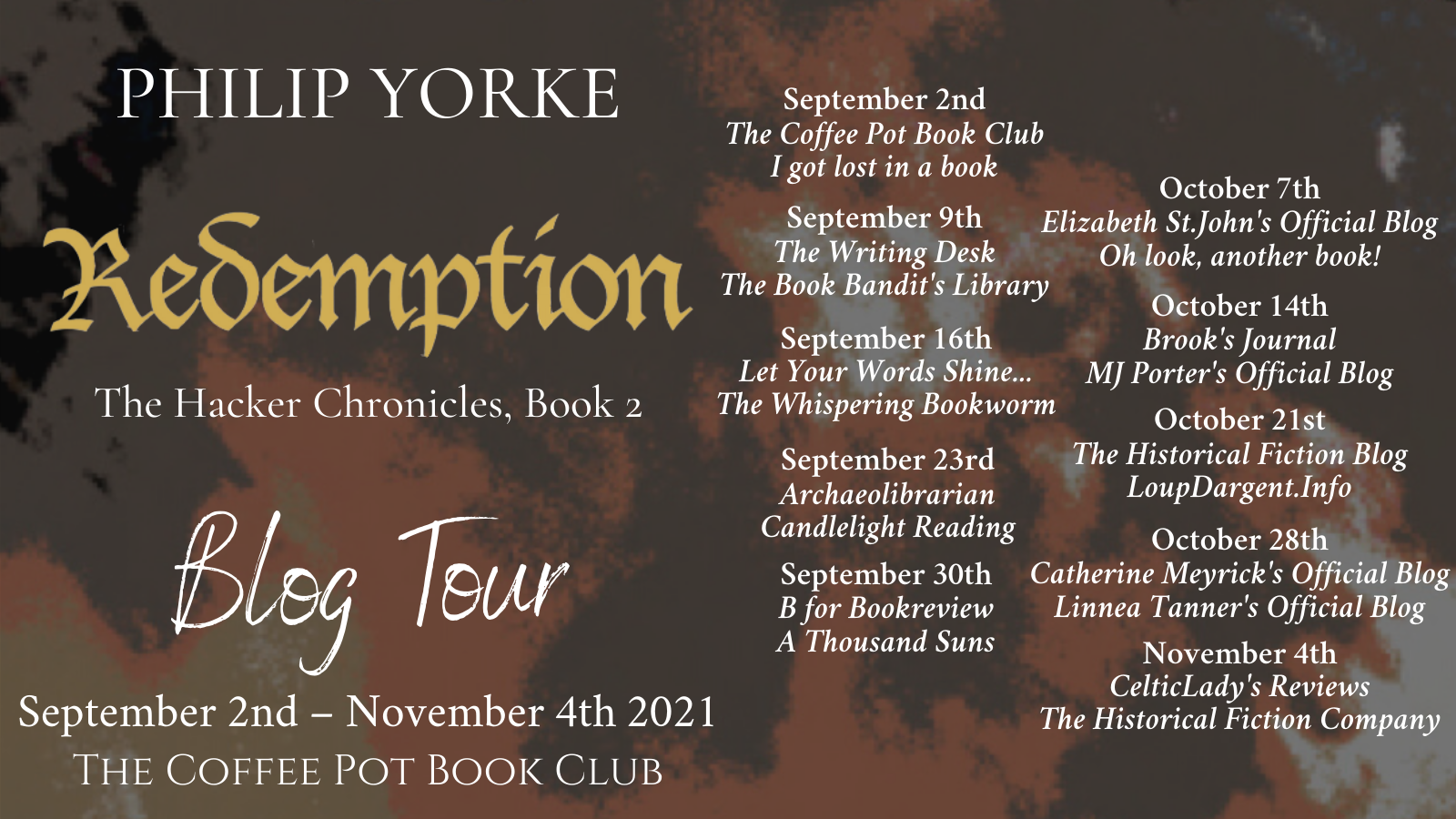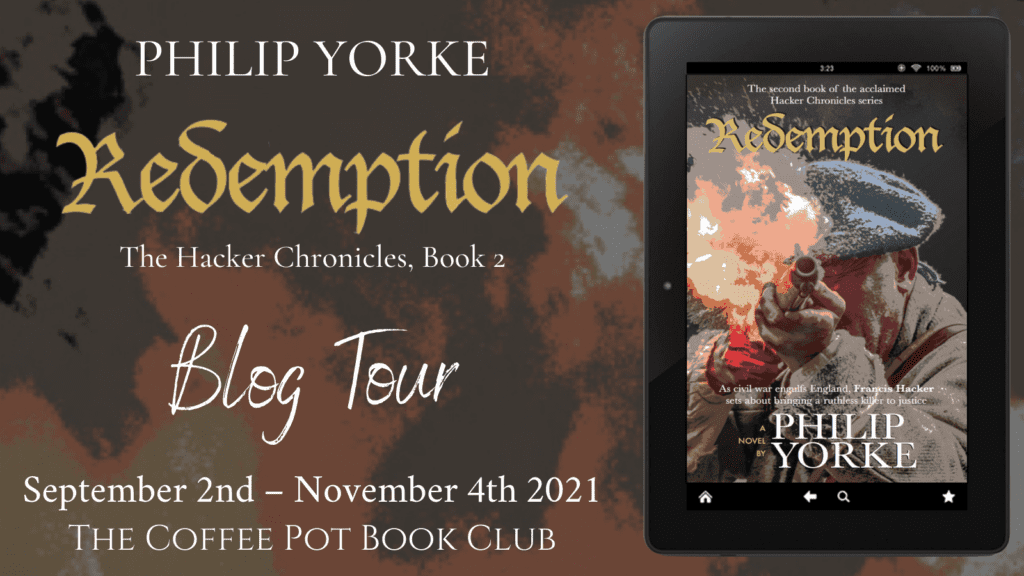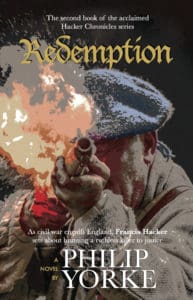
27 Oct Philip Yorke Redemption Coffee Pot Book Club Blog Tour #HistoricalFiction #EnglishCivilWar #BlogTour #CoffeePotBookClub @yorkeauthor @maryanneyarde
FEATURED AUTHOR: PHILIP YORKE
It is my pleasure to feature Philip Yorke as part of The Coffee Pot Book Club Blog Tour being held from September 2nd – November 4th, 2021. Philip Yorke is the author of the Historical Fiction novel, Redemption (The Hacker Chronicles, Book 2), which was released by Mashiach Publishing on 2nd July 2021 (480 pages).
Below are highlights of Redemption, Philip Yorke’s author bio, and his guest post about Belvoir Castle

To follow the blog tour, CLICK Tour Schedule Page
HIGHLIGHTS: REDEMPTION

Redemption
(The Hacker Chronicles, Book 2)
By Philip Yorke
Saturday, the second day of July, in the year of our Lord, 1644, will be a day long remembered by the men and women committed to ending the reign of a tyrannical King. For on this day, the forces of Charles the First were crushed on the bloody fields of Marston Moor.
The calamitous defeat forces the increasingly desperate Royalists to intensify their attempts to bring about the immediate demise of their Parliamentarian enemies. This includes devising an audacious plan to assassinate the man they believe is key to the war’s outcome.
With the plotters ready to strike, Francis Hacker, one of Parliament’s most loyal soldiers, becomes aware of the conspiracy. With little time to act, he does everything in his power to frustrate their plans. But, alas, things start to unravel when brave Hacker finds himself pitted against a ruthless and cunning mercenary, a man who will resort to anything to achieve a ‘kill’.
Buy Links:
This novel is available with #KindleUnlimited subscription.
Universal Link ♠ Amazon UK ♠ Amazon US ♠ Amazon CA ♠ Amazon AU ♠ Philip Yorke
AUTHOR BIO: PHILIP YORKE

Philip Yorke is an award-winning former Fleet Street journalist who has a special interest in history. His Hacker Chronicles series, to be told in five fast-paced historical fiction novels, tells the story of Parliamentarian soldier, Francis Hacker.
Redemption, the second book in the series, is set during the period 1644-46 (during the first English Civil War), when events take a significant turn in favour of Parliament.
Philip is married, and he and his wife have five children. He enjoys relaxing to classical music, reading the works of Nigel Tranter, Bernard Cornwell, Robyn Young and CJ Sansom, and supporting Hull City FC and Leicester Tigers RFC.
He lives in Leicestershire, England.
Social Media Links:
Website ♠ Twitter ♠ Facebook ♠ Instagram ♠ BookBub ♠ Amazon Author Page ♠ Goodreads
GUEST POST: PHILIP YORKE
Why I love Belvoir Castle…
Belvoir Castle is a special place that evokes strong feelings in me whenever I visit, which I am prone to doing on the rare occasions when I get a moment to myself.
The castle, constructed boldly in such a way it totally dominates the landscape, is not the stronghold I refer to in Redemption, my second British Civil War novel about the life and times of Francis Hacker. That fortress was modernised and rebuilt at the beginning of the nineteenth-century when the newly married Duchess of Rutland (formerly Lady Elizabeth Howard) chose architect James Wyatt to rebuild Belvoir in the romantic Gothic Revival style that was popular at the time.
It is this very citadel (towering walls et al) we all enjoy today if we make a trip to the Vale of Belvoir.
No, the fortress Francis Hacker would have known in the 1600s was the second incarnation. Originally built by the Normans and referenced in The Doomsday Book, by 1555 it had been modernised and refurbished by Thomas Manners (the first earl of Rutland) using stone from Croxton Abbey and Belvoir Priory following their dissolution.
It was in the bowels of this citadel that Francis was incarcerated on two notable occasions – in November 1643 (after the surprise Royalist raid on Melton Mowbray) and May 1645 (when he was captured on the outskirts of Leicester, after the besieged city had fallen to a sustained Royalist assault) – and where he pined for his beloved wife, Isabelle, who lived less than five miles away in Stathern. Indeed, such is the castle’s prominence, it can be clearly seen from the village. One can only guess at the torment and feelings invoked in Isabelle during this period in her life as she looked up and gazed at Belvoir’s imposing turrets – and Francis’s agonies as he waited in his small cell to be freed and returned to his loved ones?
But it isn’t just the castle that is intriguing, for an important battle and skirmish were fought in its shadows during the first of the civil wars (1642-46).
Gervase Lucas, the castle’s fearless governor, used his guile to overthrow the Earl of Rutland’s lethargic and incompetent forces in 1643 to claim it for himself and his King. The brave Lucas is said to have spotted a window open and, realising there were no guards present, made his way into the castle’s grounds, climbed up the wall and through the window, and then marched to the front gates from where his fighting men were able to achieve a complete takeover without a drop of blood being spilled. In the coming years, Lucas, who was a highly accomplished soldier, organised lightning raids that frequently frustrated Parliament’s efforts.
On Sunday 29 October 1644, less than a mile away from the castle’s walls, Francis was one of the commanding officers of a Parliamentarian force (comprising the militias of Leicester, Nottingham and Derby) that routed a 1,500-strong Royalist force led by Sir Richard Byron. Almost a third of the cavaliers are taken prisoner during the engagement and as many as 60 Royalists are killed, many of them drowned as they flee the battlefield and fall into waters known as the Mill Pool.
During the fighting, Francis was wounded. But his bravery in the field won him the plaudits of his men and cemented his reputation as a formidable leader of cavalry.
Unable to help his stricken allies, Gervase Lucas and the Belvoir garrison would have witnessed the calamitous defeat from the safety of the castle’s impregnable walls. One can only imagine how that may have felt?
King Charles visited the castle on several occasions, and Princes Rupert and Maurice are reputed to have sought sanctuary here in the weeks following the Battle of Naseby, when the King’s fortunes suffered a devastating reversal that he would never recover from.
All these events – significant chapters in British history – took place in this enticing and awe-inspiring place. And, if you allow your mind to drift back in time, it is possible to sense the presence of these men and of the events that defined the period and shaped our nation.
From the castle there is an unimpeded near 360-degree view stretching for more than 20 miles in all directions. What an advantage this must have been to Lucas as he set about attacking Parliament’s supply columns as they snaked their way from the north to places like Nottingham and Leicester. It is little wonder Parliament was furious with the Earl of Rutland (father of Lord Grey of Groby, who is a key character in Redemption) when the castle was overrun so meekly. If the Earl’s men had held Belvoir, it would have been a wonderful base to attack Newark from and thereby secure large parts of Lincolnshire and Nottinghamshire.
Unfortunately for Parliament, Lucas held on to his prize for almost three years before negotiating a surrender at the beginning of 1646 that enabled him to march from the castle with his colours flying and without surrendering his weapons. This indicates the willingness of Parliament to bring a man who had been a thorn in its side into its peace.
So, if you have a passion for history, or you simply fancy a great day out looking at something that has several great stories to tell, get yourself to Belvoir Castle. Come rain or shine, it’s a wonderful place to visit. And, for me, it has that extra bit of significance that makes every visit so memorable.

@coffeepotbookclub


Roberta Eaton Cheadle
Posted at 12:00h, 29 OctoberI like the sound of this book, Linnea. Thanks for the introduction to Philip.
Linnea Tanner
Posted at 01:22h, 09 NovemberThank you, Robbie, for visiting and commenting on Philip Yorke’s novel, “Redemption.”